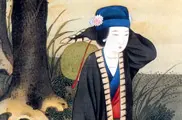Nobuo Nakatani had to catch his breath when he looked at a list of Japanese paintings in the possession of the British Museum while he was in London in 1999.
The list surprised the professor of history of medieval and modern art at Kansai University because it included works that had rarely been exhibited back in Japan.
The British Museum held 550 paintings by Osaka artists, which included many fine works from the Edo Period (1603-1867).
Many of them were donated by doctors and novelists in Britain between the 19th century and the early 20th century, according to Akiko Yano, a staff member of the Japanese Section in the museum's Department of Asia.
But some had been added to the collection since 2000 or later, including a folding screen by Yoshimura Shuzan (?-1776) and a drawing of a monkey by Mori Sosen (1747-1821), both of whom are well known.
In addition to the British Museum, several other museums in the United States and Europe hold important pieces by Osaka artists dating from the Edo Period.
Art experts say their scattering overseas is worrying because a domestic audience in Japan will have few opportunities to see them. It also means that it is more difficult for Japanese researchers to study them.
Osaka could never hold a candle to the prominent art centers of Kyoto or Edo, which is today’s Tokyo--the major hubs of Japanese artists during the Edo Period.
Kyoto was home to world-famous artistic luminaries including Ogata Korin (1658-1716), Ito Jakuchu (1716-1800) and Soga Shohaku (1730-1781); while Katsushika Hokusai (1760-1849) and Kitagawa Utamaro (1753-1806) were creating ukiyo-e masterpieces in Tokyo.
Artists began thriving in Osaka from the middle of the Edo Period--from life to genre painting.
A work by Kimura Kenkado,1736-1802, a painter from the Osaka art world. Photo: Kansai University
Mori Sosen and Kimura Kenkado (1736-1802) were among 160 key players in the “Osaka art world,” according to Nakatani.
But most of their works have long been forgotten.
Western influence
One reason, art experts say, is attributable to the nation’s extensive efforts to swiftly modernize the nation to catch up with Western countries after the Meiji government was formed in the late 19th century.
The fervor to break with the traditional way of doing things also spilled over into the art world. Japanese artists were keen to create works that resembled those of their Western counterparts.
Along the way, pictures by Osaka artists, many of which were strongly influenced by Chinese painters, especially in traditional landscape paintings, sank into oblivion.
Art experts also say that their pieces were created for merchants, their primary patrons. As a result, they were not commissioned to do many large works such as sliding or folding screen paintings that were large and powerful enough to take center stage at an exhibition.
Some art dealers, however, cited other factors for the decline in Osaka art and the flow of the city's artworks out of Japan.
They say whereas Japanese collectors tend to go after big-name artists when considering a purchase, those in the United States and Europe often bought pieces based on their genuine quality or whether they simply suited their tastes.
Bargain art
The affordable prices of Osaka artworks also contributed to their popularity among overseas collectors.
Nakatani said he was astounded when he recently found a painting by Nishiyama Hoen (1804-1867) in a pile placed in the street outside a Kyoto antique art dealer's premises.
Hoen is renowned for his realistic drawing skills and his piece, a painting of flowers and birds drawn on a fan, was sold for only 3,000 yen ($28).
While many Osaka artworks are preserved at museums overseas, Shinichi Iwasa, a staff member at the Osaka History Museum, voiced concerns over their preservation conditions.
“The humidity and other weather conditions are different (in the West) from Japan,” he said.
Kansai University, which is situated in Suita, Osaka Prefecture, is scheduled to show a selection of the 700 pieces in its collection of paintings from the Osaka art world this fall to mark the 130th anniversary of the university’s founding.
But Nakatani urged local public museums to play a more active role in preserving cultural properties from the Osaka region.
“Artworks originating in Osaka will be scattered, and there'll be a cultural void if things continue as they stand now,” he said. “Local museums should spearhead the effort to collect and exhibit them.”
(THE ASAHI SHIMBUN)
 简体中文
简体中文

